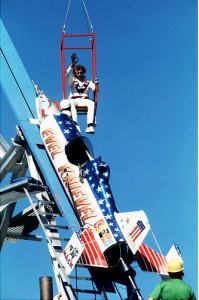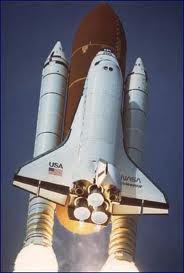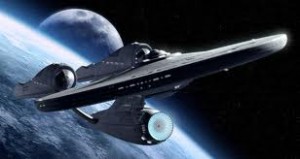NASA’s Manned [Watch-This-Space] Program
At the time of writing we are awaiting the last flight of Space Shuttle Endeavour, delayed from its initial launch attempt by a technical issue with one of it’s auxiliary power units.
While this will be the last flight of that particular orbiter, it is the second last launch for the Space Shuttle program as a whole.
Originally slated as a low cost launch vehicle, great hopes were held for the vehicle. Following on from the completely disposable Saturn Five launchers of the 1970s, the Space Shuttle was, mostly, reusable. The orbiter returned to Earth like a big glider, and its solid rocket boosters were parachuted back into the ocean, where they were retrieved, refurbished and refilled. Only the humungous external fuel tank was discarded. All of this reusability should have reduced the costs of space travel but, in practice, it did not. There is no denying… it was an expensive program.
Having said that, the 30-year Space Shuttle program was remarkable. NASA learned a great many things about operating in space, and achieved missions that were simply impossible with previous vehicles (such as the repair of the Hubble Space telescope, for example).
More importantly, the Shuttle looked cool. It was a giant leap in the direction of what a spaceship should look like.
NASA have such a long track record of amazing vehicles and awesome ideas that one can’t help but wonder… what uber-cool spaceship will these geniuses come up with next? How much closer will they take us to the Star Trek ideal?
Well, here is a top secret picture of NASA’s Space Shuttle replacement:

That’s right…like the void of space, the planned replacement for the Space Shuttle is, well, nothing. With current funding, there will be no US manned space vehicle after this year.
 In the 50 Years since astronaut Alan Shepard blasted off in his Redstone rocket the United States have become the undisputed masters of manned spaceflight. The wealth of space knowledge and expertise has been hard-won, both in money and lost lives, but it is knowledge that could be gained no other way. Each spacecraft and each mission was built on the lessons of the one before; at times some of those lessons were harsh, but all were valuable.
In the 50 Years since astronaut Alan Shepard blasted off in his Redstone rocket the United States have become the undisputed masters of manned spaceflight. The wealth of space knowledge and expertise has been hard-won, both in money and lost lives, but it is knowledge that could be gained no other way. Each spacecraft and each mission was built on the lessons of the one before; at times some of those lessons were harsh, but all were valuable.
Sadly, however, this hard earned pyramid of knowledge is at risk of rising no further. With no shuttle replacement the US will be reduced to hitching rides on the generosity and whim of others, or purchasing seats on commercial low orbit airliners. While this may be logical and financially responsible, there is no denying: they are unexciting and uninspiring alternatives.
Why are we choosing this dull, safe path?
We live in a safe world. We have OH&S; protecting us from skinning our knees, and all kinds of rules, laws and social pressures preventing us from “risky” behaviour. Risk is not something we want (we are encouraged to believe) in our everyday lives.
And yet it is risk that makes for the most compelling involvement, be it on TV or in real life. The perception of danger, particularly if it is real, engages us like nothing else can. The mundane and routine be damned! — if lives are at risk I do care!

This is an arid wasteland, not the Moon.
Disappointingly, recent media commentary likened the hunt for Osama Bin Laden to putting a man on the moon. Sure, the cost is similar. And yes, the crater-pocked dustbowls of Afghanistan and Iraq do look a little Moonlike. But are they really the same? Are these challenges apples-and-apples? Why are such comparisons made? Perhaps it is because all of our fears have been channelled by Fear Incorporated into the hunt — but now that hunt is over.
Perhaps now it is time to reacquaint ourselves with the excitement of pioneering spaceflight. Our people are jaded, however; to engage their emotions there must be an element of danger. While we may talk-the-talk of safety in our everyday lives, the truth is that life-threatening danger grips our attention like nothing else. In the context of Space and public involvement, this means that big challenges and real hazards are a required part of the mix. The lesson of Apollo was that people lost interest in spaceflight once they thought it was safe and routine. NASA needs public perception of risk to maintain the interest; spaceflight must never be routine. Big high-risk projects are essential to capturing and holding the public’s imagination.
So we need new challenges and new spacecraft — and the more ridiculous and impossible the better. We desperately need to boldly go. We need to attempt the impossible: hydrogen fuel from the Moon, terraforming Mars, mining the asteroid belt — there are plenty of dangerous challenges left to be had. Brave people will lose their lives to these outrageous adventures but, you know what? We, as a people, need these risks. And there won’t be any shortage of volunteers.
It is timely once again to consider John F. Kennedy’s 1962 “Moon Speech”, in which this visionary President said:
“we choose to go to the moon before the end of the decade and do the other things,
not because they are easy but because they are hard.”

For some challenges the safe, responsible, half-hearted approach, so encouraged by our OH&S-mad; litigious world, simply will not work. Would Bleriot, Linbergh or Smithy have crossed the waters if they were imbued with such thoughts? Would Evel Knievel have jumped a canyon in a rocket plane? Today such behaviour would be considered irrational or unwise. (Actually, it probably was then too, but they did it anyway!)
The trouble is, space is like an uncrossed ocean or rugged canyon — it is a long way to the other side. Perhaps we can make it, but do we have the courage? Is it wise? Is it rational?
Manned spaceflight is dangerous but one thing is for sure… lacklustre determination and half-way ideas simply will not get you there. Nor will a timid hand; Evel Knievel knew that backing off on the throttle was no way to cross an abyss. Kennedy knew that commitment must be total.
The participants in manned space exploration need such Knievelesque courage — courage that, despite broken bones, concussions and worse, will always recover, rebuild and reattempt. It is the kind of courage that opens the throttle 110 percent and never… ever… quits.
It’s also the kind of thinking that captivates the hearts and minds of the crowd, an essential ingredient in dollar-powering humanity to the stars.
Of course these are just fancy words. Pretty soon NASA won’t have any kind of spacecraft able to take a man or woman into orbit, let alone to any place more interesting. At least then we’ll be considered fiscally responsible, and nobody will risk getting hurt with those dangerous rockets.
“Tell me Grandpa Alan, what was Space?”
“The land at Cape Canaveral before the property developers arrived.”
Best wishes
and thanks to all
involved in the Space
Shuttle program. Your efforts
and courage have inspired many, and
added to our skills as a spacefaring people.
Please, let us not lose this hard-won knowledge!


Recent Comments